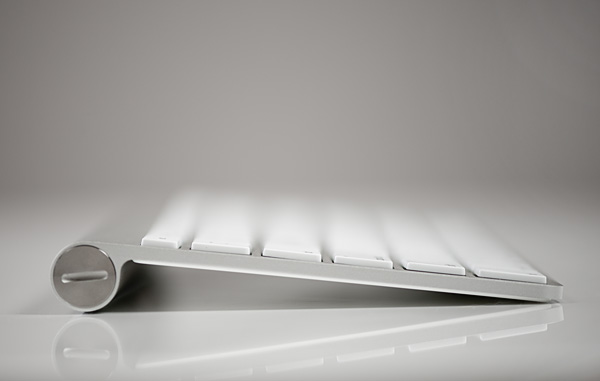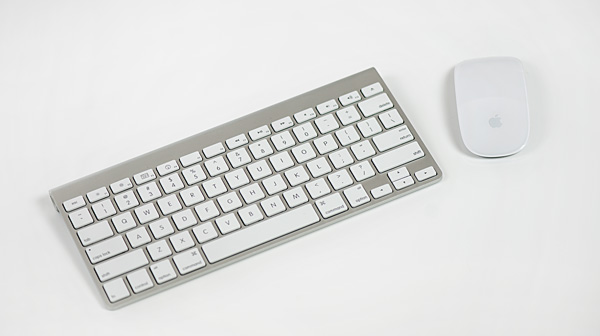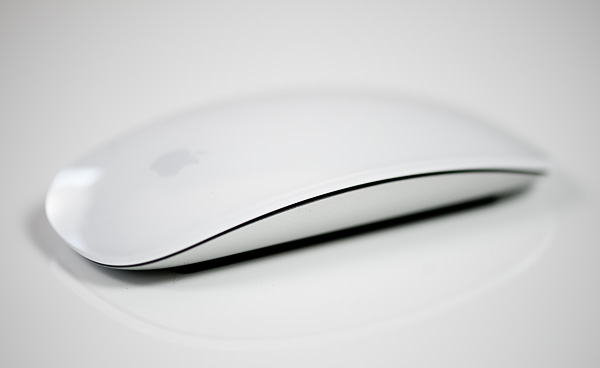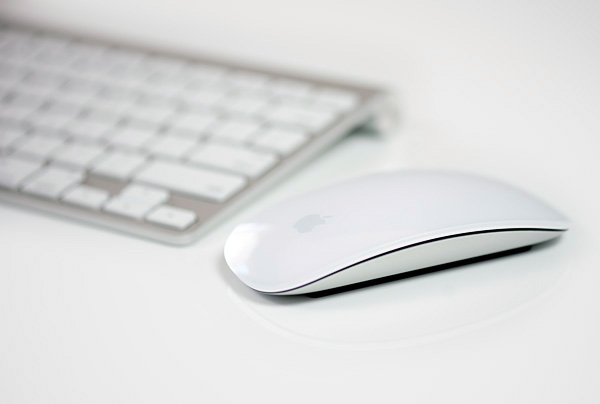The 27-inch Apple iMac Review (2011)
by Anand Lal Shimpi on May 27, 2011 2:30 AM ESTThe Peripherals
I've never been a fan of wireless peripherals - I didn't want more things to charge. Last year I finally broke down and bought a wireless mouse: Microsoft's Wireless Mobile Mouse 4000. I didn't buy it for mobility, I just liked the form factor.
The iMac comes with all wireless peripherals. In fact, if you stick with WiFi for network access, there's only a single cable you need going to the iMac: power. By default you get Apple's Wireless Keyboard and a Magic Mouse.
The Wireless Keyboard is a Bluetooth keyboard that runs off of two AA batteries. It pairs effortlessly with the iMac and I didn't encounter any issues with interference in using it. The keyboard seems to burn through batteries quicker than the mouse, perhaps that's because I type far too much or there's an issue with power management under OS X. After a week of use I'm down to 81% on a fresh pair of batteries (this is my second set).
The keyboard itself is a lot like Apple's standard aluminum keyboard, just wireless and more compact. Apple chopped off the dedicated home/end key island as well as the numeric keypad. Under OS X Cmd + Left/Right Arrow take the place of Home/End for me so part of the sacrifice isn't a problem, but the missing numeric keypad is. I do entirely too much data entry (ahem, benchmarks) to not have a dedicated numeric keypad, and for some reason Apple doesn't offer the Wireless Keyboard with one.
If you don't type tons of numbers every day however, the Wireless Keyboard is really nice. Apple had to stick a function key to the left of the control key, which is a bit bothersome (leave my control/option/cmd row alone) but it's nothing you can't get used to. The footprint is great. I have a giant desk, but I always seem to run out of desk space. The Wireless Keyboard makes it so that I can reclaim a small amount of high value desk area.
Typing feel and keyboard angle are both great - no complaints there. I'm a fan of Apple's keyboards.
Pointing devices designed in Cupertino are another story entirely. I've never liked Apple's mice. It was a big enough problem that when I first tried my Month with a Mac experience I ditched Apple's mouse. There was no way I was going to give the platform a fair shake if I had to use that thing. Since then Apple has at least enabled double clicking - the surface of the Magic Mouse is touch sensitive, click with your right finger and you get a right click. The Magic Mouse has no scroll wheel but drag your finger around on its surface and you get the best scrolling experience on a physical mouse.
The Magic Mouse is also a Bluetooth device that quickly pairs with the iMac. I noticed under Windows there's always a second or two of lag before it recognizes the mouse whereas it's useable as soon as you can see it under OS X.
My complaints about the Magic Mouse are three-fold. As I've mentioned before, the Magic Mouse doesn't have soft rubber feet that glide around on your desk. Instead you get two hard plastic strips that just seem to scrape against all surfaces. Tracking isn't a problem, but it's not a pleasant experience.
The other issue I have is the form factor itself. Microsoft's Wireless Mobile Mouse 4000 is small but it has a nice curve to it that seems to match my hand very well. The Magic Mouse on the other hand doesn't conform to any part of my body. I can lay my hand flat on it but either I'm not conditioned to do that or that's not a very comfortable way to use the mouse for long periods of a time.
Finally there's the clicking noise it makes. Modern mice seem to have a solid but more muted click, whereas the sharp click of the Magic Mouse reminds me of the past decade of Apple mice. I assume that's what Apple was going for, but Apple's market share has grown considerably in the past 10 years - it's ok to let go of some traditions.
Apple does offer the Magic Trackpad as a no-cost option. I have a love/hate relationship with the Magic Trackpad as a pointing device. Scrolling and gestures are great on it, but I prefer a normal mouse for most everything else.
















139 Comments
View All Comments
iwod - Friday, May 27, 2011 - link
My problem is with Apple's Memory upgrade. They have 2x 2GB fitted which means if you want 8GB you either have to pay sily amount to apple, or buy 4GB x2 yourself and sell your original to someone else.As soon as the hardware encoder inside Intel can be accessed through Mac OSX, i believe 4 Core 8 thread will be enough for 99.9% of my task. Next year iMac GPU upgrade should be much more important then CPU IvyBridge.
And only if Apple actually make Z68 Intel SRT to work. We need SSD, in cache or main drive.
setzer - Friday, May 27, 2011 - link
Actually these iMacs have 4 so-dimm slots, so you should be able to get 8gb's fairly easily and cheap, though if I was changing the memory I would also change the hdd in one go, opening that can is hard work..FATCamaro - Friday, May 27, 2011 - link
Yeah I bought the 27" with the SSD upgrade and bought memory separately. SSD isn't that much more than retail and the imac is a pain to open. The memory is a bit of a ripoff though.Zandros - Friday, May 27, 2011 - link
Isn't the memory accessible through removing a single screw at the bottom of the iMac, though? No need to go in through the display just for that.archer75 - Friday, May 27, 2011 - link
Actually it's 3 screws ;)But there are 4 ram slots. I just bought 16gb from newegg and plugged it in. Cost less than what apple would charge for 8gb.
KoolAidMan1 - Friday, May 27, 2011 - link
Anand - First off, great review as always.The conclusions you reached regarding the iMac's performance "finally" getting to an acceptable point is something that I came to with the release of the mid-2007 24" iMacs. Prior to that I had a PowerMac workstation for Final Cut Studio. The Core 2 Duo used in the 2007 iMac convinced me that an all-in-one would finally be a suitable replacement instead of a Mac Pro, and it was. It cost me much less than a Mac Pro while still giving me good performance and it had a 24" IPS display built in, which at the time ran $1000 by itself from NEC or Apple.
The 27" iMac released in late 2009 was a similar deal: a powerful i7-860 machine combined with a $1000 27" IPS display. iMacs make upgrading simple too, you just pack the whole thing in the original box and ship it off. The only thing you have to mental your way past is letting go of the display, and that isn't hard for me based on the fact that the 27" display in the current iMac is spectacular. It was a more than worthwhile upgrade from my prior 24" iMac, and it didn't cost me too much given that I sold the old one for about 60% of what I paid.
The 27" iMac display also functions as the primary display for my gaming PC. Unlike the iMac, my PC has SLI video cards so it can tear through that 2560x1440 res with no problem. Unlike the iMac, my PC isn't for work, it is for play. :)
This brings about my main issue with the 2011 iMacs, and it isn't something that was addressed in this review. I'm talking about the new requirements for Target Display Mode (using the iMac as a monitor for an external source) now that the mini-DP port was replaced with a Thunderbolt port. The only sources that you can use on the new iMacs are those equipped with Thunderbolt ports. For the time being this limits you to 2011 Macs, that's it. No old Macs, and no PCs until next year at the soonest.
Coming from someone that uses an iMac as an external display every day, that is pretty disappointing. Perhaps an active adapter or something will come out, but for the time being it really limits that aspect of the new iMacs.
Thanks again!
KoolAidMan1 - Friday, May 27, 2011 - link
Sidetrack - I suggest testing Starcraft 2 with ultra textures and medium settings. My PC has plenty of juice to run with everything cranked, but unless you take a still frame and examine it, the difference in visual quality between medium and ultra settings is not noticeable. The difference in framerate is VERY noticeable though, which is why I run at medium settings with ultra textures. Nice and fast while still looking pretty.I'm very curious to see how the new iMacs would run with those settings. In my own experience you're looking at nearly a doubling in framerate, but that is also with an SLI setup that may not have the same performance delta as the single GPU in the iMac. I also saw a huge difference with my laptop, but I didn't examine the framerate as closely with it so I can't say for sure if it is "nearly double" in that case.
jonwd7 - Friday, May 27, 2011 - link
The price comparison chart on the first page is wrong. I haven't made it through your review far enough to tell, but either you did not receive the high-end iMac, and you're quoting the wrong price ($1999) for the stats you've listed, or you did receive the high-end iMac, the price is right, but the stats are wrong.The stats you have listed are for the $1699 model.
krazyderek - Friday, May 27, 2011 - link
i noticed this as well, specifically this means,the $1999 model currently features the 6970 1gb, and 3.1ghz quad core i5
the $1699 model currently features the 6770 512mb not the 5xxx
in fairness the $1499 model should really be used along with the $1199 to compare to those other price points.
The $1999 model is in a completely different class and should be compared to it's appropriate competitors
psonice - Friday, May 27, 2011 - link
I'd say this isn't really much of an issue. When most people upgrade, they sell their old box - and the mac holds its value incredibly well. So what actually happens is in a couple of years you sell the old box for a large chunk of cash, and spend a smaller-than-expected sum on the new one.Basically, macs are surprisingly cheap when you factor in the resale value. You either keep them long term (and they pay for themselves then anyway), or you sell after a few years and get half your money back. This is assuming it doesn't break down - if that happens, they're very expensive ;)
Example: My 2007 24" imac was ~£1200. Resale value for similar spec on ebay today: ~£650-700. That means it's cost me around £500-£550 over 4 years, roughly the cost of a low-end desktop with an OK screen.
Oh, and I did upgrade mine to SSD (I've ignored that when looking at the prices). Yeah, it's a "fun" upgrade, and I ditched the HDD completely so I missed out on the 'removing the motherboard' stuff. Suction cups aren't actually required - you can get by with a pair of car windscreen mounts for GPS.
An easier way to access the HDD would be very welcome - especially as the new ones come with a special SATA connector so you'd need to buy an apple-specific drive too! (Not sure if this was covered in the article, I skipped a lot of it, but it's a pretty major downside for us technical types - the average punter probably wouldn't care less).